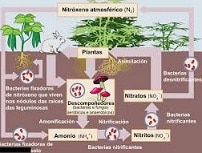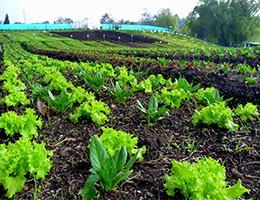 The concept of nitrification is not part of the dictionary of the Royal Spanish Academy ( RAE ). The term, in any case, is used in the field of chemistry to refer to the aerobic development of nitrates from organic substances .
The concept of nitrification is not part of the dictionary of the Royal Spanish Academy ( RAE ). The term, in any case, is used in the field of chemistry to refer to the aerobic development of nitrates from organic substances .
Nitrification is part of the so-called nitrogen cycle , which consists of several stages. The process begins when the decomposition of organic matter causes complex elements such as amino acids and proteins to degrade due to the action of fungi and bacteria.
Various microorganisms are responsible for metabolizing these simple compounds, releasing excess nitrogen as ammonia . In this way, the so-called ammonification implies that the nitrogen found as amino or imino groups in living matter is transformed into ammonia .
The next step is nitrification . In this instance, there are microorganisms that oxidize the ammonia , generating energy that they use. The oxidation of ammonia produces nitrites , which are then also oxidized to create nitrates .
It can be said, therefore, that nitrification is carried out in two phases: nitritation that certain bacteria develop by forming nitrite from ammonia or ammonium ion, and nitration that other bacteria carry out by obtaining nitrate from nitrite.
Finally, nitrate and ammonium ion are absorbed by plants through their roots. Animals , feeding on vegetables or other animals, in turn obtain the nitrogen they need and discard the ammonium ion in the form of uric acid , urea or ammonia depending on the species. These compounds end up in water or land.
In this framework we must also talk about the process that involves denitrification after nitrification, which has the goal of eliminating residual nitrogen. Throughout this microbiological process, we can observe: nitrification (autotrophic bacteria oxidize ammonium to nitrate with inorganic carbon and oxygen) and denitrification (heterotrophic bacteria reduce nitrate to molecular nitrogen gas, without oxygen but with organic carbon) .
The molecular nitrogen mentioned in the previous paragraph is an inert gas , which is found in the atmosphere in large quantities. Autotrophic bacteria, on the other hand, use an inorganic source to obtain the carbon they need to grow (for example: bicarbonate or carbon dioxide). Heterotrophic bacteria, on the other hand, use organic compounds for their development.
Let's see below the aspects on which the nitrification-denitrification process affects:
 * transforms organic and ammoniacal nitrogen into a non-polluting and inert gas;
* transforms organic and ammoniacal nitrogen into a non-polluting and inert gas;
* removes organic matter;
* if not operated correctly, has the potential to affect ammonia volatilization;
* reduces the formation of unpleasant odors;
* modifies both alkalinity and pH.
Regarding its advantages:
* removes nitrogen;
* reduces greenhouse gas emissions;
* eliminates organic matter without requiring the addition of oxygen;
* purifies the air.
Among its drawbacks, we find the following:
* makes it impossible to close the nitrogen cycle, something that does not occur with recovery processes;
* requires a relatively high economic investment, depending on the amount of equipment that must be used;
* given the large number of variables involved in the nitrification-denitrification process, constant and exhaustive control of aspects such as applied loads, residue composition, temperature and bacterial populations is needed;
* it is sensitive to inhibitors and toxins, among which we must include the substrate itself that arises during nitrification;
* sludge is produced that must be managed;
* it is not possible to pause during the process;
* each excrement must provide a sufficient amount of organic and inorganic carbon.
